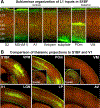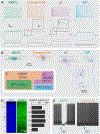Neocortical Layer 1: An Elegant Solution to Top-Down and Bottom-Up Integration
- PMID: 33730511
- PMCID: PMC9012327
- DOI: 10.1146/annurev-neuro-100520-012117
Neocortical Layer 1: An Elegant Solution to Top-Down and Bottom-Up Integration
Abstract
Many of our daily activities, such as riding a bike to work or reading a book in a noisy cafe, and highly skilled activities, such as a professional playing a tennis match or a violin concerto, depend upon the ability of the brain to quickly make moment-to-moment adjustments to our behavior in response to the results of our actions. Particularly, they depend upon the ability of the neocortex to integrate the information provided by the sensory organs (bottom-up information) with internally generated signals such as expectations or attentional signals (top-down information). This integration occurs in pyramidal cells (PCs) and their long apical dendrite, which branches extensively into a dendritic tuft in layer 1 (L1). The outermost layer of the neocortex, L1 is highly conserved across cortical areas and species. Importantly, L1 is the predominant input layer for top-down information, relayed by a rich, dense mesh of long-range projections that provide signals to the tuft branches of the PCs. Here, we discuss recent progress in our understanding of the composition of L1 and review evidence that L1 processing contributes to functions such as sensory perception, cross-modal integration, controlling states of consciousness, attention, and learning.
Keywords: GABAergic interneurons; layer 1; neocortex; predictive coding; pyramidal cell dendrites; top-down processing.
Figures



Similar articles
-
Bottom-up inputs are required for establishment of top-down connectivity onto cortical layer 1 neurogliaform cells.Neuron. 2021 Nov 3;109(21):3473-3485.e5. doi: 10.1016/j.neuron.2021.08.004. Epub 2021 Sep 2. Neuron. 2021. PMID: 34478630 Free PMC article.
-
Four Unique Interneuron Populations Reside in Neocortical Layer 1.J Neurosci. 2019 Jan 2;39(1):125-139. doi: 10.1523/JNEUROSCI.1613-18.2018. Epub 2018 Nov 9. J Neurosci. 2019. PMID: 30413647 Free PMC article.
-
Probing top-down information in neocortical layer 1.Trends Neurosci. 2023 Jan;46(1):20-31. doi: 10.1016/j.tins.2022.11.001. Epub 2022 Nov 22. Trends Neurosci. 2023. PMID: 36428192 Review.
-
Inhibitory plasticity in layer 1 - dynamic gatekeeper of neocortical associations.Curr Opin Neurobiol. 2021 Apr;67:26-33. doi: 10.1016/j.conb.2020.06.003. Epub 2020 Aug 17. Curr Opin Neurobiol. 2021. PMID: 32818814 Review.
-
Distribution and function of HCN channels in the apical dendritic tuft of neocortical pyramidal neurons.J Neurosci. 2015 Jan 21;35(3):1024-37. doi: 10.1523/JNEUROSCI.2813-14.2015. J Neurosci. 2015. PMID: 25609619 Free PMC article.
Cited by
-
High-throughput analysis of dendrite and axonal arbors reveals transcriptomic correlates of neuroanatomy.Nat Commun. 2024 Jul 27;15(1):6337. doi: 10.1038/s41467-024-50728-9. Nat Commun. 2024. PMID: 39068160 Free PMC article.
-
Context association in pyramidal neurons through local synaptic plasticity in apical dendrites.Front Neurosci. 2024 Jan 31;17:1276706. doi: 10.3389/fnins.2023.1276706. eCollection 2023. Front Neurosci. 2024. PMID: 38357522 Free PMC article.
-
Microglial TNFα controls daily changes in synaptic GABAARs and sleep slow waves.J Cell Biol. 2024 Jul 1;223(7):e202401041. doi: 10.1083/jcb.202401041. Epub 2024 May 2. J Cell Biol. 2024. PMID: 38695719 Free PMC article.
-
Bottom-up inputs are required for establishment of top-down connectivity onto cortical layer 1 neurogliaform cells.Neuron. 2021 Nov 3;109(21):3473-3485.e5. doi: 10.1016/j.neuron.2021.08.004. Epub 2021 Sep 2. Neuron. 2021. PMID: 34478630 Free PMC article.
-
Cellular mechanisms of cooperative context-sensitive predictive inference.Curr Res Neurobiol. 2024 Apr 15;6:100129. doi: 10.1016/j.crneur.2024.100129. eCollection 2024. Curr Res Neurobiol. 2024. PMID: 38665363 Free PMC article. Review.
References
-
- Arezzo JC, Vaughan HG Jr., Legatt AD. 1981. Topography and intracranial sources of somatosensory evoked potentials in the monkey. II. Cortical components. Electroencephalogr. Clin. Neurophysiol 51:1–18 - PubMed
Publication types
MeSH terms
Grants and funding
LinkOut - more resources
Full Text Sources
Other Literature Sources

